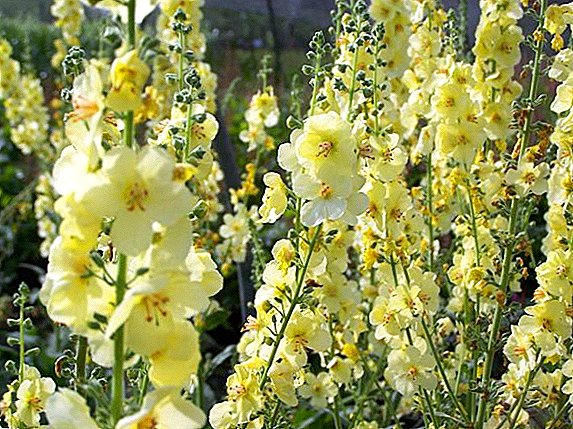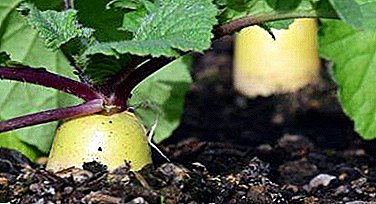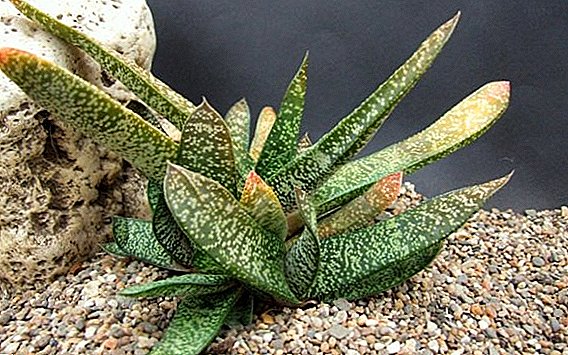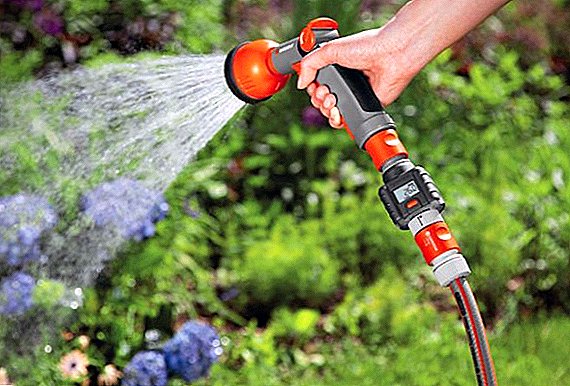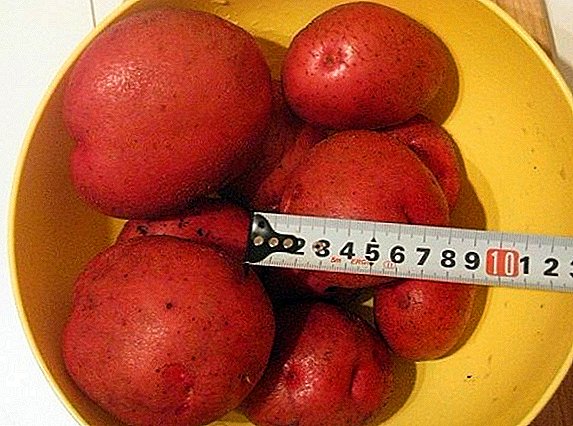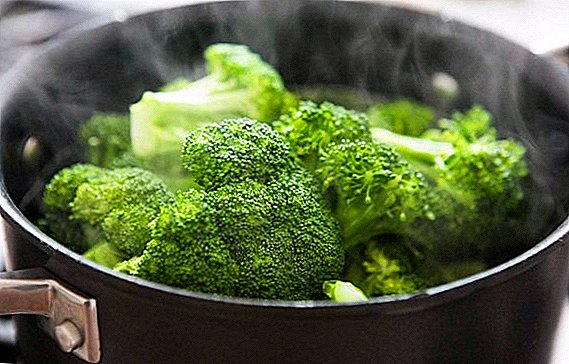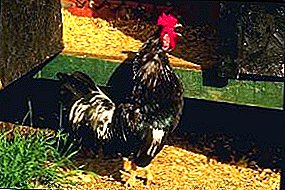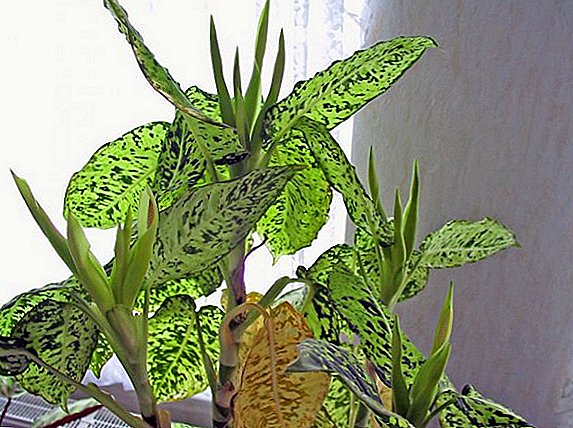 Beautiful and dangerous. It rarely blooms, but amateur flower growers are not upset by this fact. Many heat-loving plants fell in love with huge juicy leaves with an unusual color.
Beautiful and dangerous. It rarely blooms, but amateur flower growers are not upset by this fact. Many heat-loving plants fell in love with huge juicy leaves with an unusual color.
An impressive flower is no longer a rarity in offices and residential buildings. What kind of care needed dieffenbachia, try to figure it out.
Where is the best place to put dieffenbachia
 Due to the property to purify the air from formaldehyde, trichloroethane, xylene and benzene, it is recommended to put a flower in areas with unfavorable ecology - that is, areas that are heavily polluted by industrial and automobile exhausts. At home, there is no better place than a kitchen for a flowerpot, especially if its windows overlook a busy road.
Due to the property to purify the air from formaldehyde, trichloroethane, xylene and benzene, it is recommended to put a flower in areas with unfavorable ecology - that is, areas that are heavily polluted by industrial and automobile exhausts. At home, there is no better place than a kitchen for a flowerpot, especially if its windows overlook a busy road.
If you follow the rules of Feng Shui, the corner near the desk is perfect. This evergreen inhabitant of the tropics well moisturizes the air, neutralizes microbes, a beneficial effect on the nerves. But in addition to positive qualities, superstitious say, the plant selects male power. Therefore, it is feared in the bedrooms.
What kind of lighting do you need dieffenbachia
Asking how to grow Dieffenbachia, do not forget about the features of the climate of her homeland. A lot of heat, light and moisture - all that a flower needs for full growth in room conditions. Moreover, the more spots on the leaves, the more light they give.
Did you know? Room Dieffenbachia of the genus Aroid got its name from the Austrian botanist in honor of the senior gardener of the Vienna Botanical Gardens Josef Dieffenbach.
 It is important to prevent direct sunlight, which takes the plant brightness and dries it. At the same time, the light must be diffused. The ideal distance would be a meter or two from the window on the sunny side. If you have the opportunity to further organize artificial lighting, the pot can be moved away.
It is important to prevent direct sunlight, which takes the plant brightness and dries it. At the same time, the light must be diffused. The ideal distance would be a meter or two from the window on the sunny side. If you have the opportunity to further organize artificial lighting, the pot can be moved away.
Temperature for the plant
This is the next capricious picky tropican. He does not tolerate drafts, reacting to them with intense loss of foliage and wilting. In the summer in the room where dieffenbachia grows, it should be from 20 to 30 ° C, and in winter not lower than 15 ° C, otherwise do not be surprised by the sudden yellowing of the leaves.
Also avoid sudden changes in temperature. especially if you are going somewhere to transport a green pet. In winter, do not place near heating devices. Dieffenbachia loves fresh and moist air.
What should be the humidity for successful growth
Knowing that likes dieffenbachia, it is important to ensure that the humidity in the room does not fall below 65%. Of course, in the winter period in an apartment where central heating works, it’s difficult to maintain this rate. To do this, experienced florists recommend spraying and washing the leaves with warm water, the more often the better. Occasionally, small pot can arrange a shower (not cold), covering the ground in a pot.
How to plant dieffenbachia
 Through the efforts of breeders about 40 species of this decorative culture have been developed. All their representatives are powerful enough, with broad-leaf single or multiple trunks. Some are bushy. At home, they lived in a moist, humus-rich soil.
Through the efforts of breeders about 40 species of this decorative culture have been developed. All their representatives are powerful enough, with broad-leaf single or multiple trunks. Some are bushy. At home, they lived in a moist, humus-rich soil.
In addition to these features, when planting, it is necessary to consider how rapidly dieffenbachia grows.
Sprout selection
If you still do not have dieffenbachia, and you want to buy it, pay attention to the condition and viability of the germ. Carefully inspect the leaves: withered and dried around the edges indicate that the flower was kept in an insufficiently moist environment, the mode of its watering and spraying was not observed.
Soft stalks of brown color speak about the incipient rot from excess moisture. Do not take a copy with small lifeless leaves - a weak plant is unlikely to take root. Yellow leaves also indicate a lack of feeding. They should be large and juicy with a pronounced color.
A healthy culture does not have fluff and husk, it is smooth and pleasant to the touch. See if there are any pests on it. For breeding it is not necessary to buy too large vases, because soon they will have to be rejuvenated by circumcision, therefore the luxury of foliage of dieffenbachia will not please you soon. Take the average sprouts. It is better to make a purchase in the period of spring - autumn.
What should be the soil and capacity for landing
 Weakly acidic substrate for dieffenbachia can be prepared independently.
Weakly acidic substrate for dieffenbachia can be prepared independently.
It is necessary to mix turfy or leaf soil, peat, humus and river sand in a ratio of 2: 1: 1: 0.5. The soil should be light and well loosened.
Important! Ready peaty soils from flower shops with their excessive moisture capacity provoke root rot.
A full development of the root system is accompanied by a thick layer of drainage and an opening in the pot to drain the water. Capacity for planting dieffenbachia must match the size of the roots and not be selected "for growth".
Florists consider clay to be the best material, which helps retain moisture. Modern plastic and ceramics are considered uncomfortable for the flower. At the bottom of the pot as a drainage can be laid about 5 cm of brick chips and charcoal.
Planting scheme
Until the roots appear, the cutting is left in the water, adding activated carbon there, so that the water is not "rotten". In this case, the container is placed in a warm, well-lit place, avoiding direct sunlight.
The leaves are carefully sprayed. After a few weeks, small roots will erupt from the stem. When they stretch a centimeter, the stalk can be planted in the ground.
 Some growers use wet sand or peat for the rooting process, and a small sprout is covered with a plastic cup or wrapped with a film, creating greenhouse conditions. Other lovers of decorative greenery immediately drop the cut part into the ground.
Some growers use wet sand or peat for the rooting process, and a small sprout is covered with a plastic cup or wrapped with a film, creating greenhouse conditions. Other lovers of decorative greenery immediately drop the cut part into the ground.
When planting it is important to place the plant at a sufficient depth and sprinkle with soil, as well as create the necessary temperature and other conditions for growth.
Rules for the maintenance of dieffenbachia at home
A tropical guest tolerates and forgives many newbie mistakes. Dying specimens quickly take root and are easily amenable to "intensive care" conditions. But you should not test the strength of such a beautiful culture. Full care for her is to create a moist environment, timely feeding and cutting of the stems.
How to water and spray Dieffenbachia
Care at home for the flower dieffenbachia requires special attention to water procedures. The plant reacts painfully to lime, so water for irrigation and spraying should be well defended. You can filter it or boil it, or use rainwater.
Required abundant watering in summer and moderate in winter. Culture does not tolerate excess moisture. In order not to provoke rotting of the rhizomes and stems, make sure that the earth in the pot does not resemble liquid mud and does not dry out. It is desirable to alternate watering (top and through the pan). At low temperatures, spraying is best replaced by washing the leaves.
When and how to feed dieffenbachia
 The flower grows rapidly, using the entire reserve of substances necessary for its formation.
The flower grows rapidly, using the entire reserve of substances necessary for its formation.
Fertilize it in spring and summer up to three times a month. Fertilizers to choose from: liquid mineral or organic.
By the way, some types of white-leafed dieffenbachia lose this varietal feature, turning into saturated green, because of the nitrogen content in complex feedings.
Features transplant plants
The optimal period for a home transplant of dieffenbachia is February - May. The procedure should be carried out with the growth of the root system, sometimes even a couple of times a year.
To do this, choose a container with a diameter of several centimeters more than the previous one. An impressive layer of coal is placed on the bottom for fertilizer and drainage, an earthen tuber is gently rolled over the plant, the damaged roots and sticking drainage residues are removed. Top sprinkled with fresh slightly acidic soil and watered.
How to cut dieffenbachia
When you already know how to water and how to feed dieffenbachia at home, you need to find out the rules for regular pruning of the plant. Under favorable conditions, the plant releases a new leaf every week, exposing the lower part of the stem. As a result, indoor beauty loses its decoration.
Important! Any part of the stem of dieffenbachia will be suitable for choosing a sprout for planting.It needs to be cut and rooted. This event is mandatory for all varieties, some have differences. You can spend it at any time of the year, remembering that:
- poisonous plant (in order to avoid contact of toxic juice on the skin, all work should be done with gloves);
- trimming is carried out only with a sharp knife, which is pre-treated with alcohol;
- when working with dieffenbachia you need to protect your eyes so as not to sprinkle poison;
- the protruding juice is removed by promaknuv soft cloth, for disinfection sections are treated with crushed coal;
- After work, hands should be washed with soap.

Important! In the stem types of dieffenbachia, once every 3-4 years, the stem is radically cut, leaving no more than 10 cm of the stump. And only damaged and dried leaves are removed from the bush.
How to propagate dieffenbachia
There are many ways. And only at first glance it seems that reproduction and care for dieffenbachia at home is an overwork. In fact, everything is not so. To grow a new sprout of this culture is possible with the help of the apex or column live baits mentioned by us.
 Sometimes they make air slips, for which the bark in the lower bare part of the stem is cut into 5 mm, a match is put into it with hormonal powder for grafting and they tie a “wound” with moist moss or a film. After some time, there will be roots.
Sometimes they make air slips, for which the bark in the lower bare part of the stem is cut into 5 mm, a match is put into it with hormonal powder for grafting and they tie a “wound” with moist moss or a film. After some time, there will be roots.
This technology is used in May - September.
Bare trunk can be divided into many cuttings. They are dried and planted in the prepared substrate. If you do not know where the top and where is the bottom, put the cut piece horizontally and cover with a jar. New shoots will give the old stump.
Seeds are bred only by breeders. Bushes are seated by dividing.
Diseases and pests of the flower
Yellowed young leaves and wilting are the first signals to carefully inspect the plant. It can settle shchitovki, various spider mites, thrips, whitefly. Get rid of them with a cotton swab moistened with beer, soapy water, or garlic extract. Severe damage should be treated with special solutions that are commercially available. For prevention, wash the leaves regularly with warm water and moisten the flower.
 Yellow old leaves indicate the need to transplant dieffenbachia, and the loss of variegation - the lack of lighting. If the leaves are dry at the edges, it is necessary to increase the humidity. Throwing leaves means too low a temperature. With cold and acidification of the soil, the flower begins to rot.
Yellow old leaves indicate the need to transplant dieffenbachia, and the loss of variegation - the lack of lighting. If the leaves are dry at the edges, it is necessary to increase the humidity. Throwing leaves means too low a temperature. With cold and acidification of the soil, the flower begins to rot.
Its stems become discolored and become soft. Need a transplant. Do not forget: proper care produces resistance to parasites and diseases in the plant.
Did you know? Cats gladly eat diefenbachia leaves, thus driving away worms.
What they say about poisonous dieffenbachia and is it true
 Poisonous dieffenbachia or not, can surely tell those who received burns when in contact with her milk juice. It irritates the epidermis and, falling on the mucous membrane, causes swelling of the tongue and glands.
Poisonous dieffenbachia or not, can surely tell those who received burns when in contact with her milk juice. It irritates the epidermis and, falling on the mucous membrane, causes swelling of the tongue and glands.
The toxic fluid is especially dangerous for the human stomach, where it provokes vomiting and paralyzes the vocal cords. If such a nuisance has happened, you should immediately rinse your mouth with plenty of water, take activated charcoal and consult a doctor.
Did you know? In the tropics of America, where Dieffenbachia is from, it is considered a poisonous weed. Previously, the plant is widely used for the manufacture of antidotes against rodents and insects, as well as for beating slaves. After the execution, they received severe burns that did not heal for weeks.Although room dieffenbachia is less toxic compared to its wild growing sisters, you need to protect children from it, who always try everything to the tooth.


